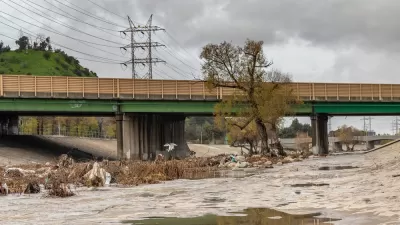Green infrastructure can help prevent flooding and replenish groundwater supplies, preventing subsidence that makes land sink.

According to an article by Matt Simon in Wired, U.S. cities could be capturing tens of billions of gallons of rainwater with more ‘spongy’ infrastructure.
A new report from the Pacific Institute indicates that urban areas generate almost 60 million acre-feet of stormwater runoff per year — much of which is diverted away from cities and into the ocean or other bodies of water. Reversing this approach to capture rainwater could help replenish groundwater resources and secure local water supplies.
Simon points to a recent report that Los Angeles captured 8.6 billion gallons of water in recent storms through a combination of green infrastructure methods. On the East Coast, cities are working to mitigate flooding through rain gardens, bioswales, and permeable pavement. “More cities are also adopting stormwater fees, charging landowners based on the amount of impervious surfaces on a property, thus encouraging them to open up more ground.”
FULL STORY: US Cities Could Be Capturing Billions of Gallons of Rain a Day

Maui's Vacation Rental Debate Turns Ugly
Verbal attacks, misinformation campaigns and fistfights plague a high-stakes debate to convert thousands of vacation rentals into long-term housing.

Planetizen Federal Action Tracker
A weekly monitor of how Trump’s orders and actions are impacting planners and planning in America.

In Urban Planning, AI Prompting Could be the New Design Thinking
Creativity has long been key to great urban design. What if we see AI as our new creative partner?

Massachusetts Budget Helps Close MBTA Budget Gap
The budget signed by Gov. Maura Healey includes $470 million in MBTA funding for the next fiscal year.

Milwaukee Launches Vision Zero Plan
Seven years after the city signed its Complete Streets Policy, the city is doubling down on its efforts to eliminate traffic deaths.

Portland Raises Parking Fees to Pay for Street Maintenance
The city is struggling to bridge a massive budget gap at the Bureau of Transportation, which largely depleted its reserves during the Civd-19 pandemic.
Urban Design for Planners 1: Software Tools
This six-course series explores essential urban design concepts using open source software and equips planners with the tools they need to participate fully in the urban design process.
Planning for Universal Design
Learn the tools for implementing Universal Design in planning regulations.
Gallatin County Department of Planning & Community Development
Heyer Gruel & Associates PA
JM Goldson LLC
City of Camden Redevelopment Agency
City of Astoria
Transportation Research & Education Center (TREC) at Portland State University
Jefferson Parish Government
Camden Redevelopment Agency
City of Claremont





























